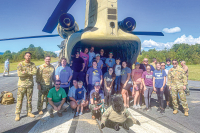Tis the elk rutting season
The shorter days and cooling temperatures of September and October were an important time of the year for the elk of Cataloochee: the fall rut. The rut is the several-week breeding period when the cows cycle into estrus and the bulls compete for dominance to mate with the cows.
A bull’s behavior changes significantly during the rut. They will have swollen necks, much like whitetail deer, and will be seen rubbing their antlers against trees or the ground. They will scrape a bare spot on the ground with their hooves and antlers and urinate in it before wallowing there.
This spreads their scent evenly across their body, announcing their presence to females and other bulls alike. A more noticeable announcement of their presence is bugling — a call the bulls make that can be heard up to a mile away in some terrains. This advertises his fitness to the cows or challenges other bulls.
If another bull accepts the challenge, the two will lock antlers and fight until an order of dominance is established. Typically, only the bigger, stronger bulls have a chance to mate with the females, ensuring that the strongest genes are passed on to the offspring. When a cow cycles into estrus it lasts for less than 24 hours, so the herd bull must remain attentive, even while other bulls are challenging him.
Throughout the rut this year the cows and calves split into two separate harems. Bull No. 16 traveled with one group while bull No. 3 traveled with the other. Both defended their respective harems against the subordinate bulls and were each seen breeding within their group.
Related Items
Bull No. 16 is currently traveling with all of the cows, but has allowed younger bulls to once again travel with the herd, a signal that the rut is over. Bull No. 3 has since left the Valley and traveled back to the Big Cove area near Cherokee.
Several bulls that had not been seen out in the fields for several months have returned. At least three of these are now seen daily traveling with the group that has been there all summer and fall. Another, bull No. 68, has left Cataloochee Valley and has been seen traveling with several other elk in the White Oak community outside the park in Haywood County.
Visitation has dramatically decreased with the closures of the campgrounds and the elk of the Valley often remain out in the fields throughout the entire day now that temperatures are cooler. These two factors combine to make a great time for visiting Cataloochee to view the elk without the relative commotion of the higher visitation seasons. For your safety and theirs, please remember to remain on the roadway when any wildlife is present.
Yarkovich is an elk biologist with the Great Smoky Mountains National Park.









